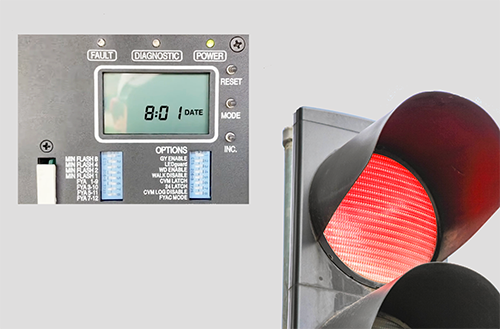
The conflict monitor is a key safety device within the traffic signal cabinet. Its primary function is to continuously check for conflicting green signals. For example, it prevents the main street and the side street from both having a green light at the same time. If it detects such a conflict, it will immediately place the entire intersection into a flashing red state, preventing a potential collision. A failure in the traffic signal's conflict monitoring system could lead to a catastrophic crash, resulting in significant liability and legal exposure for the agency and individuals responsible.
From our experience in working with hundreds of public agencies across the country, we have implemented these three best practices when dealing with conflict monitoring:
1. Knowledge about the Controller and the rest of the physical environment at the signalized intersection:
While the Federal Highway Administration (FHWA) publishes the Manual on Uniform Traffic Control Devices (MUTCD), it only governs the many actions and scenarios around traffic signal controllers. It does not specify exactly what and how components are configured by manufacturers within controller boxes. As different controller manufacturers work to differentiate themselves from each other, a vast array of configurations now exists across different manufacturers and many years of different models. All these factors play a role in how electrical signals are traveling with a control box. A conflict monitor in one model may face scenarios that don’t exist within different models. One of the first steps in preparing a field service team is arming them with the knowledge of different control box configurations to look for. This type of ongoing training should occur at least semi-annually and can often be done with manufacturers being on-site to help present and educate field service teams.
2. Conduct annual conflict monitor testing with a certified conflict monitor unit (CMU) tester:
If our experience has taught us anything it is that conflict monitor testing is treated very differently from state to state, and agency to agency. We recommend routine testing with a certified CMU tester to ensure the conflict monitor is working correctly. This is important for a few reasons. Over time, electrical components can degrade or fail. Tests verify the monitor's ability to detect and react to a conflict. This proactive approach helps to catch potential failures before they cause an incident. By conducting and documenting these tests, you create a paper trail demonstrating that you've followed best practices and due diligence. This documentation is invaluable in the event of a lawsuit. It shows that the agency took reasonable steps to maintain a safe intersection. Conducting these tests also helps remove the chance of being deemed negligent in court, greatly reducing your legal liability.
3. Train team members on False Positives
Technicians need to understand the specifications, limitations, and common failure modes of the conflict monitor as well as the CMU tester. This base of knowledge helps technicians identify some of the false positives that may occur including;
External Interference: Electromagnetic interference (EMI) from nearby power lines, radio signals, or even other energized equipment can skew readings.
Environmental Factors: Temperature, humidity, and dust can affect insulation resistance and other measurements. For example, a humid environment can cause a megohmmeter to give a low reading, mimicking an insulation fault.
Ground Loops & Improper Grounding: Poor grounding can create voltage differences between different parts of a system, leading to incorrect readings.
Improper Connections: Loose or corroded test leads, or incorrect probe placement, can lead to inaccurate measurements.
And finally, whenever in doubt never trust a single reading. We train technicians to take the extra time to test and re-test, and even perform cross verification in any questionable situations.
We hope that some of our experience and best practice guidelines can inform your next phase of CMU testing.